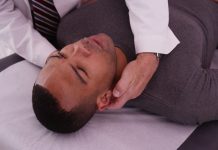Nansel D, Jansen R, Cremata E, Dhami MS, Holley D
Palmer College of Chiropractic-West,
Sunnyvale, CA 94087
The biomechanical and physiological effects of a single, unilateral lower cervical spinal adjustment delivered to the most restricted side of cervical lateral-flexion passive end-range were examined. Only healthy, asymptomatic male subjects who exhibited goniometrically verified lateral-flexion passive range of motion asymmetries of 10 degrees or greater on the morning of the experiment were chosen for the study. Posttreatment goniometric measurements revealed that in sham-adjusted controls, mean lateral-flexion asymmetries had not changed significantly during the 4-hr time period examined. However, in subjects who received lower cervical adjustments, dramatic ameliorations of asymmetry magnitude were observed which persisted throughout the entire 4-hr posttreatment time period. On the other hand, in the face of this rather robust biomechanical effect, heart rate and blood pressure measurements obtained at -60 and -15 min prior to treatments, and at 5, 30, 60, 120 and 240 min following treatments, revealed no significant differences between adjusted and sham-adjusted subjects at any of the time periods examined. Consistent with this, analysis of the plasma concentrations of norepinephrine, epinephrine and dopamine in serial blood samples collected at these same times also failed to reveal significant differences between treatment groups at any of the time periods examined. The results of this investigation indicate that lower cervical adjustments are capable, at least in asymptomatic subjects, of inducing relatively robust biomechanical effects related to passive cervical end-range capability without simultaneously inducing significant alterations in the overall activity of the sympathetic nervous system.








